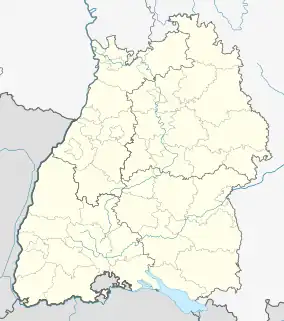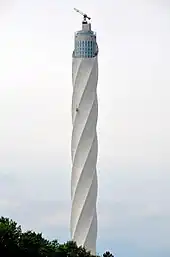Rottweil
Rottweil (German: [ˈʁɔtvaɪl] ⓘ; Alemannic: Rautweil) is a town in southwest Germany in the state of Baden-Württemberg. Rottweil was a free imperial city for nearly 600 years.
Rottweil | |
|---|---|
 A bird's-eye view of the whole city | |
 Coat of arms | |
Location of Rottweil within Rottweil district  | |
 Rottweil  Rottweil | |
| Coordinates: 48°10′5″N 8°37′29″E | |
| Country | Germany |
| State | Baden-Württemberg |
| District | Rottweil |
| Government | |
| • Lord mayor (2022–30) | Christian Ruf[1] (CDU) |
| Area | |
| • Total | 71.76 km2 (27.71 sq mi) |
| Highest elevation | 609 m (1,998 ft) |
| Lowest elevation | 557 m (1,827 ft) |
| Population (2021-12-31)[2] | |
| • Total | 24,984 |
| • Density | 350/km2 (900/sq mi) |
| Time zone | UTC+01:00 (CET) |
| • Summer (DST) | UTC+02:00 (CEST) |
| Postal codes | 78628, 78652 (Unterrotenstein) |
| Dialling codes | 0741, 07427 (Neukirch) |
| Vehicle registration | RW |
| Website | www.rottweil.de |
.jpg.webp)
Located between the Black Forest and the Swabian Alps, Rottweil has nearly 25,000 inhabitants as of 2020. The town is famous for its medieval center and for its traditional carnival (called "Fasnet" in the local Swabian dialect). It is the oldest town in Baden-Württemberg,[3] and its appearance has changed very little since the 16th century.
The town gives its name to the Rottweiler dog breed.
History
Imperial City of Rottweil Reichsstadt Rottweil | |||||||||
|---|---|---|---|---|---|---|---|---|---|
| 1140–1802 | |||||||||
| Status | Free imperial city | ||||||||
| Capital | Rottweil | ||||||||
| Government | Republic | ||||||||
| Historical era | Middle Ages | ||||||||
• Founded | AD 73 | ||||||||
• Gained Imp. immediacy | 1140 | ||||||||
• Treaty with Swiss | 1463 | ||||||||
| 1519 | |||||||||
| 1802 | |||||||||
| |||||||||
Imperial Abbey of Rottenmünster Reichskloster Rottenmünster | |||||||||
|---|---|---|---|---|---|---|---|---|---|
| 1237–1802 | |||||||||
| Status | Imperial abbey | ||||||||
| Capital | Rottenmünster | ||||||||
| Government | Imperial abbey | ||||||||
| Historical era | Middle Ages | ||||||||
• Founded | 9 May 2018 | ||||||||
• Gained Imp. immediacy | 1237 | ||||||||
| 1643 | |||||||||
• Mediatised to Württemberg | 23 November 1802 | ||||||||
• Abbey abandoned | 1850 | ||||||||
| |||||||||

Rottweil was founded by the Romans in AD 73 as Arae Flaviae and became a municipium, but there are traces of human settlement going back to 2000 BC. Roman baths and an Orpheus mosaic of c. AD 180 date from the time of Roman settlement. The present town became a ducal and a royal court before 771 and in 1268 it became a free imperial city.
In 1463 Rottweil joined the Swiss Confederacy under the pretence of a temporary alliance. In 1476 the Rottweilers fought on the Swiss side against Charles the Bold in the Battle of Morat. In 1512, Pope Julius II gave the city a valuable "Julius banner" for its services in the 1508–1510 "Great Pavier Campaign" to expel the French.[4] In 1519, the Rottweilers left the old Swiss alliance. They joined a new one in which their membership was extended indefinitely – the so-called "Eternal Covenant".
Rottweil thus became a centre of the Swiss Confederation. The relations between the Swiss Confederation and Rottweil cooled rapidly during the Protestant Reformation. When Rottweil was troubled by wars, however, it still asked the Confederates for help.[5]
In the Rottweil Witch Hunts from 1546 to 1661, 266 so-called witches, wizards and magicians were executed in the imperial city of Rottweil. On April 15, 2015, they were given a posthumous pardon. An official apology was given by the City Council about 400 years after their violent deaths.[6]
Rottweil lost both its status as free city and its alliance with the Swiss Confederacy with the conquest of the region by Napoleon in 1803.
Lord mayors since the 19th century
- 1820–1833: Max Joseph von Khuon, Schultheiß
- 1833–1845: Max Teufel
- 1845–1848: Karl Dinkelmann
- 1848–1851: Kaspar Rapp
- 1852–1887: Johann Baptist Marx
- 1887–1923: Edwin Glückher
- 1924–1943: Josef Abrell
- 1943–1944: Otto Mann
- 1944–1945: Paul Fritz
- 1945–1946: Franz Mederle
- 1946–1965: Arnulf Gutknecht
- 1965–1985: Ulrich Regelmann, mayor; from 1970 Lord Mayor
- 1985–2001: Michael Arnold
- 2001–2009: Thomas Engeser
- 2009–2022: Ralf Broß[7][8][9]
- 2022–present: Christian Ruf[1]
Economy
During the Middle Ages, Rottweil used to be a flourishing imperial city with great economic and cultural influence.[10] In 1868, Rottweil was connected to Stuttgart by rail, which boosted the economy of the region.[10]
Today, most companies in Rottweil are either small or medium-sized.[11] A trading and shopping town with a high level of innovation that benefits from its well developed educational and transport infrastructure, Rottweil has many industrial companies and a steadily growing proportion of knowledge-intensive service jobs.[11]
At 7.9%, Rottweil has one of the highest academic rates in the region.[11]
Media
Local events in Rottweil are reported in the daily newspaper Schwarzwälder Bote, the Stadtanzeiger, online and once a week in the print edition Neue Rottweiler Zeitung, the TV station Regio TV Bodensee and the local radio station antenne 1 Neckarburg Rock & Pop, which is based in the district.
Infrastructure
Road traffic
By car, Rottweil can be reached via the Bundesautobahn 81 Stuttgart-Singen, exit Rottweil. The city lies on the Bundesstraße 27 between Schaffhausen and Stuttgart, on the Bundesstraße 14, which runs from Stockach on Lake Constance via Tuttlingen to Rottweil and on via Horb am Neckar to Stuttgart, and on the Bundesstraße 462 from Rottweil through the Black Forest to Freudenstadt and Rastatt.
Bicycle traffic
Rottweil is located on the Neckartal-Radweg along the Neckar River via Horb, Tübingen, Stuttgart, Heilbronn and Heidelberg to Mannheim.
Air traffic

In the neighboring village of Zepfenhan, about 12 km (7.5 mi) away, is the Flugplatz Rottweil-Zepfenhan (Rottweil-Zepfenhan airfield), which can be approached by small aircraft. The nearest commercial airports are Stuttgart Airport and Zurich Airport.
Education
Rottweil has three Gymnasien (Albertus-Magnus-Gymnasium, Droste-Hülshoff-Gymnasium, Leibniz-Gymnasium), one Realschule, one Förderschule (Achert-Schule), three Grundschulen (Eichendorff-Grundschule, Grundschule Neufra and Grundschule Neukirch), and four Hauptschulen (GHS Göllsdorf, Johanniter-Grund- und Hauptschule, Konrad-Witz-Grund- und Hauptschule and Römer-Grund- und Hauptschule).
Main sights

- The late-Romanesque and Gothic–era Münster Heiliges Kreuz ("Minster of the Holy Cross"), built over a pre-existing church from 1270. It features a crucifix by Veit Stoss and noteworthy Gothic sculptures.
- Kapellenkirche (1330–1340), a Gothic church with a tower and with three statue-decorated portals
- Lorenzkapelle ("Church of St. Lawrence", 16th century) in late Gothic style. It houses some two hundred works by Swabian masters and Gothic altarpieces from the 14th and 15th centuries.
- The town's museum, including a notable Roman mosaic with the legend of Orpheus
- The late-Gothic town hall (1521)
- St. Pelagius, a Romanesque church from the 12th century. Excavations have brought to light Roman baths on the same site.
- Dominican Museum of Rottweil – local branch of the Landesmuseum Württemberg
- ThyssenKrupp constructed a $45 million, 807-foot (246 m) tower, the Rottweil Test Tower. The tower is a research facility for the company and is used to test new elevator cars and technologies. When the tower was completed in 2017, it was the tallest elevator test tower in the world.[14][lower-alpha 1] The tower has 12 elevator shafts.[15]
Twin towns – sister cities
Notable people
- Konrad Witz (1400/10–1445/46), painter
- Adam of Rottweil, 15th-century scholar and printer
- Franz Xavier Wernz (1842–1914), Superior General of the Society of Jesus
- Erwin Teufel (born 1939), politician (CDU), former minister president of Baden-Württemberg
- Rüdiger Safranski (born 1945), writer and literary scholar
- Matthias Hölle (born 1951), opera bass
- Anne Haigis (born 1955), musician and singer
- Wolfgang Stryi (1957–2005), jazz musician
- Andreas Schwab (born 1973), politician (CDU) and member of the European Parliament
- Johannes Erath (born 1975), opera director
- Christoph Burkard (born 1983), Paralympic swimmer
- Maximiliane Rall (born 1993), footballer
- Joshua Kimmich (born 1995), footballer
Trivia
- The Rottweiler dog breed is named after this town; it used to be a butcher's dog in the region.[17]
- "Das Mädchen aus Rottweil" is a song by the German band Die Toten Hosen.[18]
Gallery

 Depiction of St. Veronica's sudarium over the portal of the Minster of the Holy Cross
Depiction of St. Veronica's sudarium over the portal of the Minster of the Holy Cross A statue for Rottweiler dogs in Rottweil
A statue for Rottweiler dogs in Rottweil Rottweiler "Fasnet"
Rottweiler "Fasnet"
.jpg.webp) Rottweil station with ThyssenKrupp Test Tower in the background
Rottweil station with ThyssenKrupp Test Tower in the background
See also
Notes
- There are higher elevator test towers now, see List of elevator test towers.
References
- Oberbürgermeisterwahl Rottweil 2022, Staatsanzeiger.
- "Bevölkerung nach Nationalität und Geschlecht am 31. Dezember 2021" [Population by nationality and sex as of December 31, 2021] (CSV) (in German). Statistisches Landesamt Baden-Württemberg. June 2022.
- Website of Dominikaner Museum Rottweil (retrieved May 22, 2014), on permanent display is a wooden table from August 4, AD 186 naming arae flaviae as municipium thus making Rottweil the oldest town in Baden-Württemberg Archived 2014-05-21 at the Wayback Machine
- Hecht, Winfried. "The Julius Banner of the Village of Rottweil". ETHZürich. Retrieved 2019-01-25.
- Hecht, Winfried. "Rottweil". Historical Dictionary of Switzerland. Retrieved 2019-01-25.
- Zeck, Mario (2000). "Im Rauch gehen Himmel geschüggt", Hexenverfolgung in der Reichsstadt Rottweil. Stuttgart. p. 43.
- "Oberbürgermeisterwahl 2009 - vorläufiges amtliches Endergebnis" (in German). Kommunale Informationsverarbeitung Reutlingen-Ulm. Retrieved 2 February 2017.
- "Ralf Broß - Oberbürgermeister - Stadt Rottweil" (in German). XING. Retrieved 2 February 2017.
- "Mitarbeiter: Broß, Ralf" (in German). Rottweil (official site). Retrieved 2 February 2017.
- "Wirtschaft | Landkreis Rottweil". www.landkreis-rottweil.de. Retrieved 2021-12-18.
- "Wirtschaftsstruktur | Stadt Rottweil - Die älteste Stadt Baden Württembergs". www.rottweil.de. Retrieved 2021-12-18.
- "Peter-Uhren GmbH – Rottweiler Bilder". www.rottweil.net. Retrieved 2021-12-22.
- "Ehemalige Pflug-Brauerei – Rottweiler Bilder". www.rottweil.net. Retrieved 2021-12-18.
- Dillon, Conor (2015-06-26). "World's tallest elevator tower rises in Rottweil, Germany | DW | 26.06.2015". Deutsche Welle. Retrieved 2021-12-13.
- Brown, Eliot (September 15, 2015). "Elevators Elevate German City's Image". The Wall Street Journal. ISSN 0099-9660. Retrieved 2 February 2017.
- "Rottweil und seine Partnerschaften". rottweil.de (in German). Rottweil. Retrieved 2021-03-16.
- "Rottweiler | Description, Temperament, Images, & Facts | Britannica". www.britannica.com. Retrieved 2021-12-24.
- "Menschen Das Mädchen aus Rottweil - verzweifelt gesucht!". faz.net (in German). 2002-08-07. Retrieved 2021-12-24.
External links
- Official website
 (in German)
(in German) - Feast of Fools: Medieval Carnival Celebrations in Rottweil
- History and territory of the former Reichsstadt Rottweil
- Pictures of and stories about Rottweil

